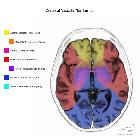Basilaristhrombose















Acute occlusion of the basilar artery may cause brainstem or thalamic ischemia or infarction. It is a true neuro-interventional emergency and, if not treated early, brainstem infarction results in rapid deterioration in the level of consciousness and ultimately death. It is one of the posterior circulation infarctions.
Epidemiology
Occlusions of the posterior circulation arteries are related to a fifth of all strokes, and basilar artery occlusion is rare (~1% of all strokes) .
Clinical presentation
Patients with acute occlusion of the basilar artery will present with sudden and dramatic neurological impairment, the exact characteristics of which will depend on the site of occlusion:
- sudden death/loss of consciousness
- top of the basilar syndrome
- visual and oculomotor deficits
- behavioral abnormalities
- somnolence, hallucinations and dream-like behavior
- motor dysfunction is often absent
- proximal and mid portions of the basilar artery (pons) can result in patients being 'locked in'
- complete loss of movement (quadriparesis and lower cranial dysfunction)
- preserved consciousness
- preserved ocular movements (often only vertical gaze)
Pathology
Acute occlusion of the basilar artery can be due to either thromboembolism, atherosclerosis or propagation of intracranial dissection. Although these may occur anywhere, each of these have predilections for different segments of the basilar artery:
- vertebrobasilar junction
- thromboembolism (e.g. cardioembolic)
- atherosclerosis with thrombosis
- propagation of vertebral arterial dissection (rare)
- midsegment
- atherosclerosis with thrombosis
- distal third or basilar tip
- thromboembolic (e.g. top of the basilar syndrome)
Radiographic features
Angiography (DSA)
Remains the gold standard for the diagnosis of basilar artery occlusion. However, DSA is used only after non-invasive imaging for therapeutic recanalization (see case 1). Images demonstrate a filling defect within the vessel.
US
- transcranial Doppler
- absence of signal in the basilar artery
- indirect signs such as abnormal waveforms in the vertebral arteries and collateral flow
CT
- non-contrast CT
- hyperdense basilar artery (the basilar artery equivalent of the hyperdense MCA sign), present in ~65%
- a high index of suspicion is needed in the correct clinical setting as the diagnosis can easily be missed (often only present on 1 or 2 slices); additionally it is well recognized that acute clots are of lower attenuation than chronic clots
- hypoattenuation delineates tissue with ischemic damage (limitations due beam-hardening artifacts limit the visualization of the brainstem on CT)
- contrast CT
- CTA: filling defect within the vessel
- CT perfusion: distinguishes ischemic penumbra area from an irreversibly damaged area (infarct core)
MRI
- loss of flow void within the basilar artery on spin-echo and FLAIR images
- DWI: restricted diffusion within infarcted tissue
- FLAIR/T2: hyperintense signal within infarcted tissue
Treatment and prognosis
Acute occlusion of the basilar artery is a life threatening event, which carries a terrible prognosis: ~90% mortality depending on the location, and high morbidity in the survivors .
Multidisciplinary consensus for individualized management is difficult to achieve in a time-critical fashion.
Treatment usually involves catheter-directed intra-arterial thrombolysis and intravenous heparin, which carries a risk of hemorrhage of up to 15%. Mechanical embolectomy with a clot retrieval device has been used in selected cases.
Predictors of Outcome after mechanical thrombectomy
Age, Gender
Analysis of the BASICS RCT reports no significant differences between age groups observed for recanalization rate and incidence of symptomatic intracranial hemorrhage (sICH). Patients ≥75 years with basilar artery occlusion have an increased risk of poor outcome compared with younger patients, but a substantial group of patients ≥75 years survive with a good functional outcome . No significant gender differences for outcome and recanalization were observed, regardless of treatment modality .
Collateral flow
Several studies, including a series of 21 patients and another of 104 patients, have found that the presence of bilateral posterior communicating arteries on pretreatment CTA was associated with more favorable outcomes after mechanical thrombectomy in basilar artery occlusion .
Vertebral artery stenosis
From the BASICS study, in patients with acute basilar artery occlusion, unilateral vertebral artery occlusion or stenosis ≥50% is frequent, but not associated with an increased risk of poor outcome or death. Patients with basilar artery occlusion and bilateral vertebral occlusion had a slightly increased risk of poor outcomes .
Vertebrobasilar artery calcification
In a cohort study of 64 patients, vertebrobasilar artery calcification was found to be an independent predictor of outcome and associated with reduced functional independence and increased mortality in this demographic .
Posterior circulation Acute Stroke Prognosis Early CT score (pc-ASPECTS)
An analysis of BASICS suggested that a cerebral blood volume (CBV) pc-ASPECTS <8 may indicate patients with high case fatality. However, further evidence is needed as CTA and CTP were available in only 27/592 BASICS patients (4.6%) .
Siehe auch:
- hyperdense Media
- hyperdense Media
- Ischämischer Schlaganfall
- Atherosklerose
- hyperdense Arteria basilaris
- top of the basilar artery syndrome
- zerebrale CT-Angiographie
- superselective thrombolysis in basilary artery thrombosis
und weiter:

 Assoziationen und Differentialdiagnosen zu Basilaristhrombose:
Assoziationen und Differentialdiagnosen zu Basilaristhrombose:


